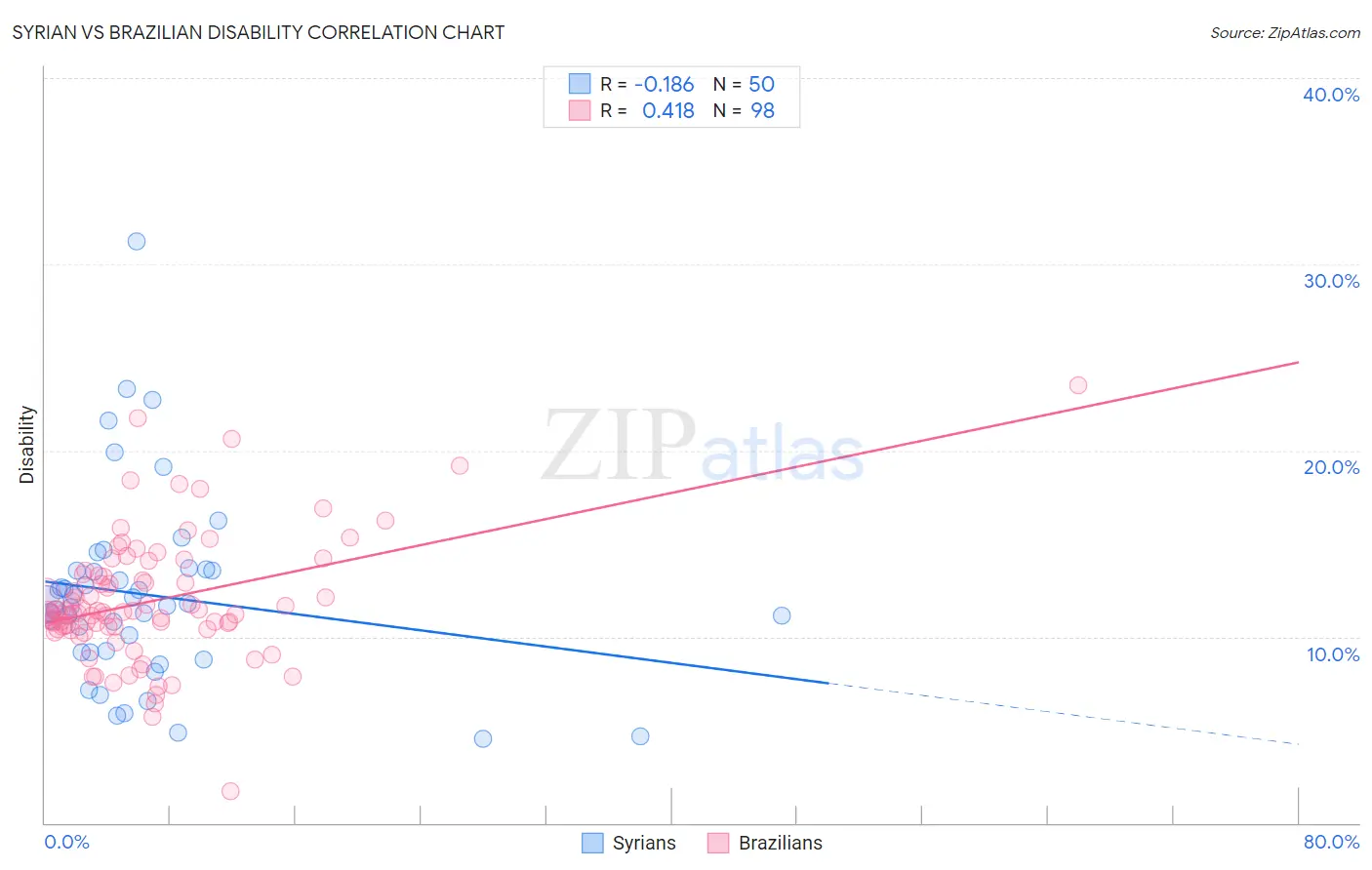Syrian vs Brazilian Disability
COMPARE
Syrian
Brazilian
Disability
Disability Comparison
Syrians
Brazilians
11.7%
DISABILITY
58.5/ 100
METRIC RATING
164th/ 347
METRIC RANK
11.4%
DISABILITY
93.3/ 100
METRIC RATING
122nd/ 347
METRIC RANK
Syrian vs Brazilian Disability Correlation Chart
The statistical analysis conducted on geographies consisting of 266,315,243 people shows a poor negative correlation between the proportion of Syrians and percentage of population with a disability in the United States with a correlation coefficient (R) of -0.186 and weighted average of 11.7%. Similarly, the statistical analysis conducted on geographies consisting of 323,954,129 people shows a moderate positive correlation between the proportion of Brazilians and percentage of population with a disability in the United States with a correlation coefficient (R) of 0.418 and weighted average of 11.4%, a difference of 2.6%.

Disability Correlation Summary
| Measurement | Syrian | Brazilian |
| Minimum | 4.5% | 1.7% |
| Maximum | 31.2% | 23.5% |
| Range | 26.7% | 21.8% |
| Mean | 12.2% | 11.9% |
| Median | 11.7% | 11.3% |
| Interquartile 25% (IQ1) | 9.2% | 10.5% |
| Interquartile 75% (IQ3) | 13.6% | 13.3% |
| Interquartile Range (IQR) | 4.4% | 2.8% |
| Standard Deviation (Sample) | 5.1% | 3.3% |
| Standard Deviation (Population) | 5.0% | 3.3% |
Similar Demographics by Disability
Demographics Similar to Syrians by Disability
In terms of disability, the demographic groups most similar to Syrians are Immigrants from Trinidad and Tobago (11.7%, a difference of 0.020%), Immigrants from Haiti (11.7%, a difference of 0.030%), Cuban (11.7%, a difference of 0.080%), Pakistani (11.7%, a difference of 0.17%), and Estonian (11.7%, a difference of 0.18%).
| Demographics | Rating | Rank | Disability |
| Immigrants | Middle Africa | 69.5 /100 | #157 | Good 11.6% |
| Armenians | 65.9 /100 | #158 | Good 11.6% |
| Guatemalans | 65.1 /100 | #159 | Good 11.6% |
| Immigrants | Barbados | 64.2 /100 | #160 | Good 11.6% |
| Immigrants | Cuba | 62.8 /100 | #161 | Good 11.6% |
| Immigrants | Haiti | 59.2 /100 | #162 | Average 11.7% |
| Immigrants | Trinidad and Tobago | 58.9 /100 | #163 | Average 11.7% |
| Syrians | 58.5 /100 | #164 | Average 11.7% |
| Cubans | 56.7 /100 | #165 | Average 11.7% |
| Pakistanis | 54.7 /100 | #166 | Average 11.7% |
| Estonians | 54.4 /100 | #167 | Average 11.7% |
| Immigrants | Latin America | 54.1 /100 | #168 | Average 11.7% |
| Immigrants | Austria | 53.4 /100 | #169 | Average 11.7% |
| Immigrants | Albania | 52.8 /100 | #170 | Average 11.7% |
| Immigrants | Southern Europe | 52.8 /100 | #171 | Average 11.7% |
Demographics Similar to Brazilians by Disability
In terms of disability, the demographic groups most similar to Brazilians are Immigrants from Costa Rica (11.4%, a difference of 0.020%), Immigrants from North Macedonia (11.4%, a difference of 0.030%), Central American (11.4%, a difference of 0.040%), Korean (11.3%, a difference of 0.090%), and Luxembourger (11.3%, a difference of 0.10%).
| Demographics | Rating | Rank | Disability |
| Immigrants | Philippines | 94.6 /100 | #115 | Exceptional 11.3% |
| Immigrants | Northern Europe | 94.1 /100 | #116 | Exceptional 11.3% |
| Luxembourgers | 93.9 /100 | #117 | Exceptional 11.3% |
| Koreans | 93.8 /100 | #118 | Exceptional 11.3% |
| Central Americans | 93.5 /100 | #119 | Exceptional 11.4% |
| Immigrants | North Macedonia | 93.5 /100 | #120 | Exceptional 11.4% |
| Immigrants | Costa Rica | 93.4 /100 | #121 | Exceptional 11.4% |
| Brazilians | 93.3 /100 | #122 | Exceptional 11.4% |
| South Africans | 92.3 /100 | #123 | Exceptional 11.4% |
| South American Indians | 92.2 /100 | #124 | Exceptional 11.4% |
| Costa Ricans | 91.9 /100 | #125 | Exceptional 11.4% |
| Immigrants | Latvia | 90.9 /100 | #126 | Exceptional 11.4% |
| Immigrants | Italy | 90.4 /100 | #127 | Exceptional 11.4% |
| Immigrants | Europe | 90.4 /100 | #128 | Exceptional 11.4% |
| Macedonians | 90.3 /100 | #129 | Exceptional 11.4% |